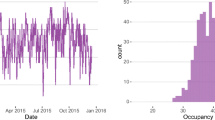Abstract
Hourly changes in patient census and acuity require hospitals to update their staffing needs on a continuing basis. This paper discusses the problem that management faces several times a day as the demand for nursing services departs from the planned schedule. Prior to the start of each shift, the number of nurses who are scheduled to be on duty over the next 24 hours is compared with the number actually available, and if shortages exist a series of decisions have to be made to ensure that each unit in the hospital has sufficient coverage. These decisions involve the use of overtime, outside nurses, and floaters. To address this problem, we have developed an integer programming model that takes the current set of rosters for regular and pool nurses and the expected demand for the upcoming 24 hours as input, and produces a revised schedule that makes the most efficient use of the available resources. The model is formulated and solved at a hospital-wide level rather than for each unit separately. To determine its applicability, a representative set of scenarios was investigated using data obtained from a medium-size facility in the U.S. with 14 units. The results indicate that problem instances with up to 120 nurses can be solved in a negligible amount of time.
Similar content being viewed by others
References
E.K. Burke, P.D. Causmaecker, G. Vanden Berghe, and H. Van Landeghem, The state of the art of nurse rostering, Journal of Scheduling 7(6) (2004) 441–499.
B. Cheang, H. Li, A. Lim, and B. Rodrigues, Nurse Rostering Problems—A bibliographic survey, European Journal of Operational Research 151(1) (2003) 447–460.
J.F. Bard and H.W. Purnomo, Preference scheduling for nurses using column generation, European Journal of Operational Research 164(2) (2005) 510–534.
H. Beaulieu, J.A. Ferland, G. Bernard, and P. Michelon, A mathematical programming approach for scheduling physicians in the emergency room, Health Care Management Science 3 (2000) 193–200.
I. Berrada, J.A. Ferland, and P. Michelon, A multi-objective approach to nurse scheduling with both hard and soft constraints, Socio-Economic Planning Sciences 30(3) (1996) 183–193.
F.F. Easton, D.F. Rossin, and W.S. Borders, Analysis of alternative scheduling policies for hospital nurses, Production and Operations Management 1 (1992) 159–174.
B. Jaumard, F. Semet, and T. Vovor, A generalized linear programming model for nurse scheduling, European Journal of Operational Research 107 (1998) 1–18.
S.C. Sarin and S. Aggarwal, Modeling and algorithmic development of a staff scheduling problem, European Journal of Operational Research 128 (2001) 558–569.
S.P. Siferd and W. Benton, A decision modes for shift scheduling of nurses, European Journal of Operational Research 74(3) (1994) 519–527.
C. Valouxis and E. Housos, Hybrid optimization techniques for the workshift and rest assignment of nursing personnel, Artificial Intelligence in Medicine 20 (2000) 155–175.
S. Petrovic, G. Beddoe, and G. Vanden Berghe, Storing and adapting repair experiences in personnel rostering, in: Practice and Theory of Automated Timetabling, Fourth International Conference, eds. E.K. Burke and P. De Causmaecker (Lecture Notes in Computer Science, Springer, Gent, 2003 vol. 2740, pp. 185–186).
D.M. Warner, Scheduling nursing personnel according to nursing preference: A mathematical programming approach, Operations Research 24(5) (1976) 842–856.
D. Lukman, J. May, L. Shuman, and H. Wolfe, Knowledge-based schedule formulation and maintenance under uncertainty, Journal of the Society for Health Systems 2 (1991) 42–64.
J.A. Filar, P. Manyem, and K. White, How airlines and airports recover from schedule perturbations: A survey, Annals of Operations Research 108 (2001) 315–333.
G. Wei, G. Yu, and M. Song, Optimization model and algorithm for crew management during airline irregular operations, Journal of Combinatorial Optimization 1 (1997) 305–321.
G. Yu, M.F. Argüello, M. Song, S. McCowan, and A. White, A new era of crew recovery at continental airlines, Interfaces 33(1) (2003) 5–22.
O. Berman and R.C. Larson, A queueing control model for retail services having back room operations and cross-trained workers, Computers & Operations Research 31 (2004) 201–222.
G.M. Thompson, Accounting for the multi-period impact of service when determining employee requirements for labor scheduling, Journal of Operations Management 11(3) (1993) 269–287.
J.F. Bard, G. Yu, and M.F. Argüello, Optimizing aircraft routings in response to groundings and delays, IIE Transactions on Operations Engineering 33(10) (2001) 931–947.
J. Clausen, J. Hansen, J. Larsen, and A. Larsen, Disruption management, OR/MS Today 28(5) (2001) 40–43.
G. Yu and X. Qi, Disruption Management: Framework, Models and Applications (World Scientific, Singapore, 2004).
G.M. Thompson, Shift Scheduling in services when employees have limited availability: An L.P. Approach, Journal of Operations Management 9(3) (1990) 352–370.
Author information
Authors and Affiliations
Corresponding author
Rights and permissions
About this article
Cite this article
Bard, J.F., Purnomo, H.W. Short-Term Nurse Scheduling in Response to Daily Fluctuations in Supply and Demand. Health Care Manage Sci 8, 315–324 (2005). https://doi.org/10.1007/s10729-005-4141-9
Received:
Accepted:
Issue Date:
DOI: https://doi.org/10.1007/s10729-005-4141-9




